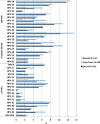High human papillomavirus (HPV) prevalence in South African adolescents and young women encourages expanded HPV vaccination campaigns
- PMID: 29293566
- PMCID: PMC5749739
- DOI: 10.1371/journal.pone.0190166
High human papillomavirus (HPV) prevalence in South African adolescents and young women encourages expanded HPV vaccination campaigns
Abstract
The objectives of the study were to investigate prevalence of cervical human papillomavirus (HPV) genotypes to inform HPV vaccination strategy in South Africa and to study factors associated with HPV prevalence. Sexually active, HIV-negative women, aged 16-22 years recruited from Soweto (n = 143) and Cape Town (n = 148) were tested for cervical HPV and other genital infections. Overall HPV prevalence was 66.7% (194/291) in young women. Cape Town women were more likely to have multiple HPV infections than the Soweto women (48.0%, 71/148 versus 35.0%, 50/143 respectively, p = 0.033) and probable HR-HPV types (34.5%, 51/148 versus 21.7%, 31/143 respectively, p = 0.022). The most frequently detected HPV types were HPV-16 (11.7%), HPV-58 (10.3%), HPV-51 (8.9%), HPV-66 (8.6%), HPV-18 and HPV-81 (7.6% each). HPV types targeted by the bivalent HPV vaccine (HPV-16/18) were detected in 18.6% (54/291) of women, while those in the quadrivalent vaccine (HPV-6/11/16/18) were detected in 24.7% (72/291) of women; and those in the nonavalent vaccine (HPV-6/11/16/18/31/33/45/52/58) were detected in 38.5% (112/291) of women. In a multivariable analysis, bacterial vaginosis remained significantly associated with HPV infection (OR: 4.0, 95% CI: 1.4-12.6). Women were more likely to be HPV positive if they had received treatment for STI during the past 6-months (OR: 3.4, 95% CI: 1.1-12.4) or if they had ever been pregnant (OR: 2.3, 95% CI: 1.1-5.5). Compared to women who reported only one sexual partner, those with increased number of lifetime sex partners were more likely to have HPV (4-10 partners: OR: 2.9, 95% CI: 1.1-8.0). The high prevalence of HPV types targeted by the nonavalent HPV vaccine encourages the introduction of this vaccine and catch-up HPV vaccination campaigns in South Africa. The high burden of BV and concurrent STIs also highlights the need to improve the prevention and appropriate management of sexually-acquired and other genital tract infections in South African youth.
Conflict of interest statement
Figures



References
-
- Chinsembu KC. Sexually transmitted infections in adolescents. The Open Infectious Diseases Journal. 2009;3:107–17.
-
- Newton-Levinson A, Leichliter JS, Chandra-Mouli V. Sexually Transmitted Infection Services for Adolescents and Youth in Low- and Middle-Income Countries: Perceived and Experienced Barriers to Accessing Care. The Journal of adolescent health: official publication of the Society for Adolescent Medicine. 2016;59(1):7–16. Epub 2016/06/25. doi: 10.1016/j.jadohealth.2016.03.014 . - DOI - PMC - PubMed
-
- Schiffman M, Castle PE. The promise of global cervical-cancer prevention. The New England journal of medicine. 2005;353(20):2101–4. Epub 2005/11/18. doi: 10.1056/NEJMp058171 . - DOI - PubMed
-
- McGrath N, Nyirenda M, Hosegood V, Newell ML. Age at first sex in rural South Africa. Sexually transmitted infections. 2009;85 Suppl 1:i49–55. doi: 10.1136/sti.2008.033324 ; PubMed Central PMCID: PMC2654105. - DOI - PMC - PubMed
-
- Pettifor AE, Rees HV, Kleinschmidt I, Steffenson AE, MacPhail C, Hlongwa-Madikizela L, et al. Young people's sexual health in South Africa: HIV prevalence and sexual behaviors from a nationally representative household survey. Aids. 2005;19(14):1525–34. . - PubMed
Publication types
MeSH terms
Substances
LinkOut - more resources
Full Text Sources
Other Literature Sources
Medical
Miscellaneous

